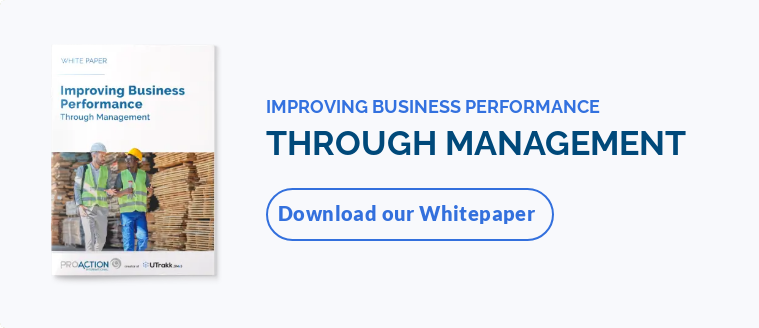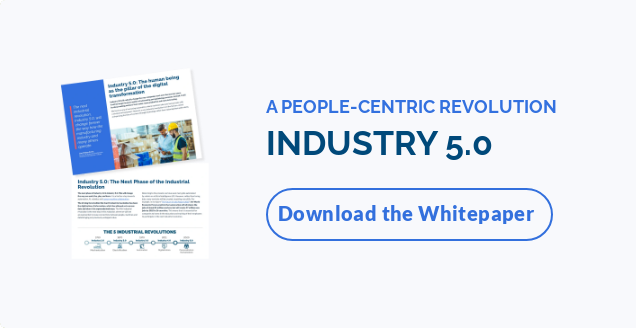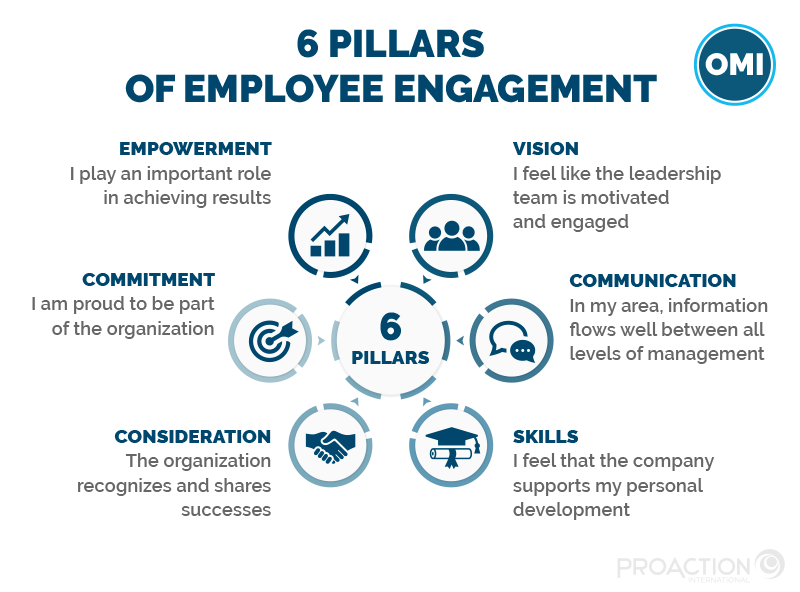What is employee engagement?
While companies may define employee engagement according to their own needs, the essential characteristics of an engaged employee are: They know what their role is, what their job entails, and they want to do it.
They are loyal to their employer and productive. They are motivated to work toward the success of their organization and know what success looks like.
A mobilized employee will always try to surpass himself, give his best to reach his organization's objectives and align himself with its needs. Their goal will be to evolve and improve while showing a genuine desire to contribute to the long-term growth of the company and the people who are part of it.
Mobilization at work can be measured individually, but especially collectively, with the idea of a common cause. It concerns all employees. It is precisely the strength of this mobilized group that will positively influence the development of the organization. It is, therefore, a matter of establishing a culture of mobilization, with workers who come together to move in the same direction.
Here is a simple comparison to better differentiate between disengagement and engagement at work:
- Unengaged and disengaged employees tend to stick to the bare minimum by performing only the tasks related to their job. Therefore, their behaviour within the company is primarily individual.
- Engaged employees are satisfied with their personal lives and working conditions. They are attached to their jobs and the organization's success, leading to increased productivity and the desire to do more and better. They also interact with their colleagues to move forward (information sharing, mutual aid, initiatives, Etc.).
-
You can create a motivated and committed workforce that contributes to your organization's long-term growth by improving and maintaining employee engagement efforts. An employee engagement strategy is essential to measure and sustain employee engagement. In addition, a mobilization culture must be established, with workers coming together to move in the same direction, thus reinforcing the sense of belonging and creating a positive work environment.
Engaged employees are beneficial in many ways, such as increasing productivity and better business outcomes, reducing absenteeism and employee turnover rates, fostering healthy communication, and enabling effective change management.
By improving organizational success and improving employee engagement afterward, you can create a motivated and committed workforce dedicated to contributing to the long-term growth of your organization.
The benefits of engaged employees
Employee mobilization has positive effects on several levels. It allows to :
- Strengthen the sense of belonging
- Create a positive work environment
- Increase the well-being of individuals at work
- Decrease the rate of absenteeism
- Reduce the rate of employee turnover
- Foster healthy and transparent communications between employees and managers
- Improve change management
- Establish a shared vision and goal
- Increase employee productivity and, therefore, the company's performance
- Improve the organizational culture
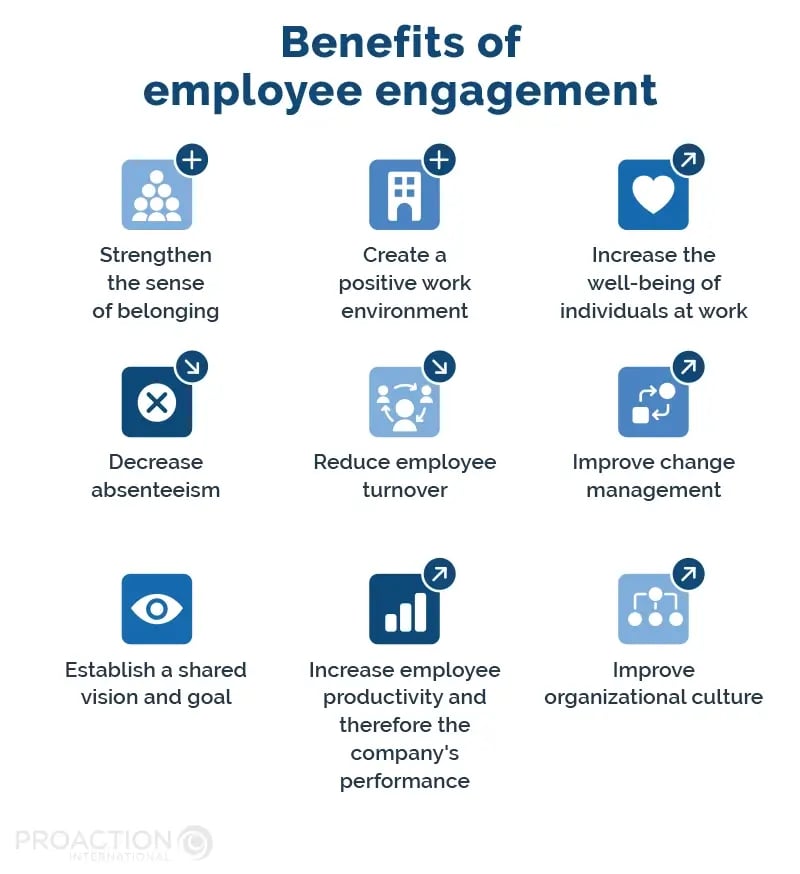
The manager: a key player in the employee engagement strategy
According to a study conducted by Gallup, a global analysis and consulting firm, 50% of employees leave their company solely because of their manager.
Engagement at work depends, above all, on the ability of the immediate superior to unite and motivate their team. In addition, they must establish a climate of trust and support, listen to and respect their employees, and show benevolence while keeping employees informed and guiding them in the right direction, i.e., the company's vision.
He also encourages them to be more autonomous, to take the initiative, and to take responsibility. Their management style is participatory, as they promote teamwork and communication.
A mobilizing manager can bring together the strengths of each team member and use them to achieve the desired objectives and make the entire organization grow. They present themself as an inspiring and humane leader whom people want to follow.
Coaches' advice: good practices to improve employee engagement
1) Maintain effective communication between employees and managers
Direct supervisors must develop strong relationships with their employees.
Maintaining effective communication is essential in any organization. It starts with the relationship between managers and employees.
Here are some tips for smoother communication:
Build a relationship of trust
Managers need to establish and maintain an emotional connection with their team. They must be honest and authentic, practice open listening, and respect employees' opinions.
Creating a safe space facilitates a culture of transparency rather than one of unspoken words.
Use simple and precise language.
Managers should use clear, straightforward verbal or body language to avoid confusion or misunderstanding. Clear, concise, and specific examples of current situations are preferred. That removes personal biases that can impede discernment when emotionally charged.
Listen actively
Managers must listen and allow employees to express themselves without interruption. Showing interest in their concerns and asking open-ended questions to understand better are two effective ways to make others feel secure.
Provide constructive feedback
The ultimate goal is to create a culture of constructive feedback. To do this, providing constructive and regular feedback helps employees improve. Of course, the manager must also know how to recognize employees' good work and contributions, but above all, be able to receive honest feedback.
Mario Sergio Garcia - Management coach, Proaction International
2) Determine objectives and key indicators to measure progress
At the level of mobilization, it is essential to help the employee set goals to achieve clear expectations. When people set goals in their private and professional life, they acquire benchmarks, action plans, and specific destinations.
Often, on the professional side, it is already fixed. For example, we will seek 10% productivity in our sector. As coaches, we will also dive into the motivational fiber by asking these questions:
"What are your goals as a leader? What are your management practices? What do you want to improve regarding your managerial posture, communication, planning, and execution? For example, it could be setting standards, getting the best out of your team, the best out of your employee, your performance evaluations, Etc. So we will set objectives.
But we must also be able to determine clear indicators:
What shows us that the leader is improving, like motivation or competence? Is it giving training, for example, Etc.?
What is fundamental in terms of mobilization is to determine objectives and key indicators to measure progress.
Léo Normandin - Management coach, Proaction International
3) Job descriptions: preparing employees to win
Employee engagement starts before the onboarding. Therefore, it is surprising that employees sometimes need help understanding what to do. Job descriptions are rarely explicit about the demands of daily work.
This lack of understanding leads to questions and frustration between the senior leaders, managers, and staff, and anxiety when an employee is unsure if they can meet the requirements.
To improve this situation and foster engagement, writing job descriptions as if creating a checklist for getting the job done is essential. Consider the same tasks that the job requires and write the job description in plain language to accurately describe what is "right" and what you expect the person to do. This way, an employee can easily say, "Yes, I did that today.
For example, if a worker is to supervise production workers, it may be good to consider wording such as:
- Monitor and control machine speed, labour utilization, and air quality;
- Monitor and control machine speed, labour utilization per line, and overtime to maximize the number of parts produced per work hour;
- Supervise production results and take corrective action to control and continually improve quality.
Written job descriptions make it easy to check the quality of an employee's work and help them develop improvement plans to address performance shortfalls.
Matthew Pirie - Management coach, Proaction International
Seven key behaviors to improve employee engagement
It's not often that you develop skills by accident and suddenly wake up and become a proven leader. That experience, usually a series of trials and errors, makes the difference in a manager's journey toward developing their leadership style. Unfortunately, several years of management experience does not guarantee effective and healthy leadership for employees and oneself.
Magali Mansion- Management coach, Proaction International
Magali Mansion, Management Coach at Proaction International, presents seven behaviours to adopt to foster employee engagement:
- Decide to embody coaching and take opportunities to support your employees' continuous learning consciously. Rather than leading, ask them how they would execute that task to achieve the goal best. Develop your emotional intelligence.
- Decide to do and say what you mean quietly and assertively in all circumstances. Develop your assertiveness.
- Get into the habit of stepping back and asking yourself the best angle to approach the situation. Also, help your employees develop reflective practices to create awareness.
- Be aware that only some have the same experience, but more importantly, the same way of thinking and communicating. Your ability to adapt your communication style according to the person you are communicating with will facilitate understanding the tasks and objectives employees need to achieve. In addition, your flexibility in your relationships will create a safe space to communicate effectively and reveal yourself.
- Developing your active listening skills is a high-value-added skill; investing time in developing it will give you an excellent return in your daily life. In addition, communicating and listening will increase the accuracy of your message and reach your audience—a superb mobilization key to add a valuable tool to your toolbox.
- Instill the desire to renew and learn in your collaborators by setting an example through your curiosity. Transferring your knowledge will also create the need to know and acquire new skills.
- Asking for feedback from your employees is an essential behaviour to develop if you want to mobilize your employees and encourage them to create, perform and increase their level of autonomy. By remaining open to constructive criticism, by example, you send a clear message that vulnerability is desirable, that being infallible is not realistic, and that, as a team, we can support each other in our personal growth and development.
It is no secret that a company's culture influences the personal development of a manager's leadership, and the models of leaders that gravitate around him will influence his style. The good news is that, like any skill we wish to acquire or improve, it is possible to train and develop a leadership of impact through practice, reading, and voluntary training.
Magali Mansion- Management coach, Proaction International
Without embarking on a crash course in leadership, you can now decide to adopt the seven keys presented and put them into practice during your daily activities. Identify one or two concrete actions to implement for each key. Mobilization begins by setting the conditions and accessible tools that stimulate curiosity and the desire to develop.
Key Performance Indicators for employee engagement
Key Performance Indicators (KPIs) and Key Behavioral Indicators (KBIs) are essential to measuring organizational employee engagement. These metrics help companies assess whether their employees are committed to their jobs and the organization, how motivated they are, and how passionate they are about their work.
KPIs for employee engagement can include productivity levels, employee absenteeism, and turnover rates. In addition, organizations may also track employee satisfaction levels, job fulfillment, and employer branding, as these factors offer insights into the story of engagement within the workforce.
Measuring KPIs for employee engagement is crucial for understanding how effective an organization's employee engagement strategy has been and making necessary adjustments to improve it.
By developing and tracking these KPIs, organizations can create a culture of engagement that increases efficiency, loyalty, and success.
How to measure employee engagement with KBIs?
By closely monitoring Key Behavioral Indicators (KBIs), an organization can ensure that employees remain motivated, productive, and committed to the company's goals. In this regard, we use Key Behavioral Indicators to measure employee engagement. Here are two of them:
The Organizational Mobilization Index (OMI)
The Organizational Mobilization Index (OMI) measures employee engagement, providing valuable insights into well-being and overall engagement. Based on six main factors, employee engagement surveys help track these metrics effectively. These factors include:
- Empowerment - allowing employees to participate in decision-making and show initiative.
- Vision - clarifying the organization's goals and strategy.
- Communication - ensuring information circulates across all levels of the hierarchy.
- Competence - supporting employees' career advancement.
- Consideration - recognizing, encouraging, and valuing employees.
- Mobilization - transforming employees into proud ambassadors of the organization.
These six essential factors contribute significantly to fostering a thriving organizational culture and promoting employee engagement and satisfaction. As a result, organizations can enhance overall performance and maintain a healthy work environment by prioritizing these elements.
The Personal Satisfaction Index (PSI)
This indicator is vital for evaluating managers' engagement levels and performance readiness and identifying disengagement areas. The PSI helps optimize well-being, mindset, and conditions for success by prioritizing efforts to enable managers to achieve a positive state.
Five key elements contribute to personal satisfaction:
- Sense of accomplishment - reflecting potential fulfillment, development, and exceptional potential.
- Self-esteem - showcasing trust in one's skills and judgment.
- Confidence - positively influencing colleagues.
- Belonging - indicating effective leadership.
- Communication - differentiating between the desire to lead and belonging.
Utilizing the PSI supports initiatives to enhance individuals' satisfaction with their roles and the organization, fostering a confident, authoritative, and industry-specific approach to management and leadership. In addition, this practical application promotes real-world success through clear, concise, and professional guidance.
By closely monitoring these KPIs, organizations can better understand and foster employee engagement, leading to a thriving business.
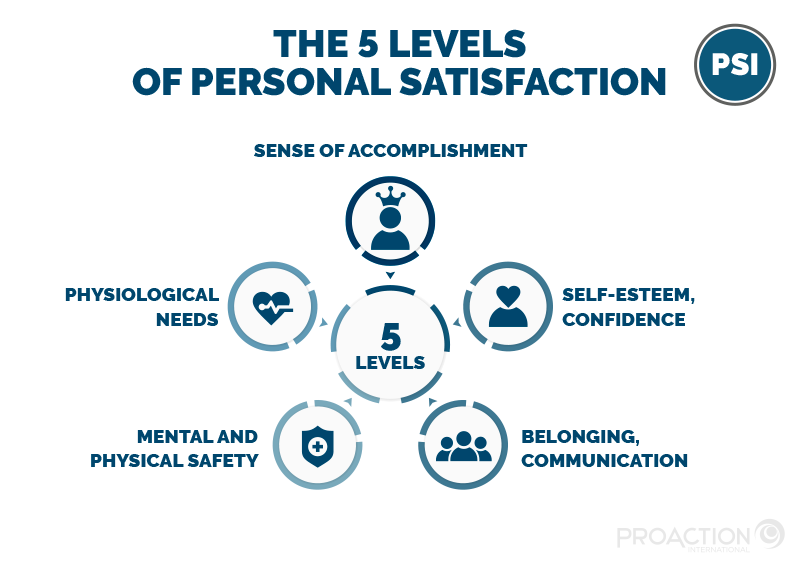
Conclusion
Employee engagement is crucial for the growth and success of any organization. However, cultivating a culture of engagement can be challenging for managers. That is where executive coaching can play a significant role.
By providing managers with the necessary tools and skills to succeed in their employee engagement strategy, executive coaching can help them to identify the factors that promote employee engagement and develop strategies to improve it. Additionally, executive coaching can help managers to address the issues that hinder employee engagement, such as poor communication, lack of recognition, and low job satisfaction. With the guidance of an executive coach, managers can create a work environment that fosters employee engagement and motivates employees to perform at their best.
An employee who can develop professionally and personally at work is an employee who will grow your company at the same rate as their investment in new skills.







